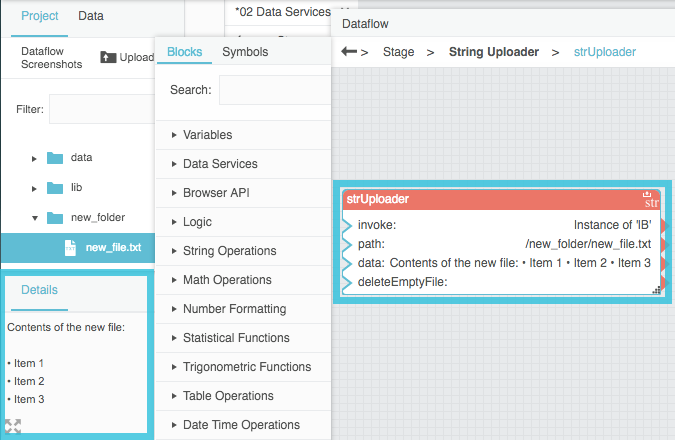String Uploader
| Block Group: | Data Services |
| Block Icon: |  |
The String Uploader block saves a string as a new file in this project. If a file with the specified name and extension already exists, this block replaces the contents of the existing file.
For information on using dataflow blocks, see Dataflow.
Note
You might need to collapse the folder and re-expand it, or save your work and refresh the browser, to see the new file.
Input/Output Properties
The following properties of the String Uploader block can take input and give output.
- invoke (trigger)
- enabled (boolean)
- path (string)
- data (string)
- deleteEmptyFile (boolean)
invoke causes the string to be uploaded. The invoke property works only if enabled is set to TRUE.
enabled specifies whether the String Uploader block is enabled.
- TRUE—The string is uploaded when this block is invoked.
- FALSE—Nothing happens when this block is invoked.
path specifies where to upload the string, relative to the root of this project. Must include a file name and extension.
- To save to the root, enter
/<filename>.<extension>. - To save to the
assetsfolder, enterassets/<filename>.<extension>.
data holds the string that gets uploaded.
deleteEmptyFile specifies what happens when the data property is null.
- TRUE: If data is null, no new file is created. If the file already exists, it is deleted.
- FALSE: If data is null, a file is created when this block is invoked. The file is empty. If the file already exists, its contents are deleted but the file remains.
Output Properties
The following properties of the String Uploader block can give output but cannot take input.
- onComplete (event)
- error (string)
onComplete fires when the string has been uploaded.
error returns the error message, if any.
Example
The following image demonstrates a typical use of the String Uploader block. In this example, when the String Uploader block is invoked, a file named new_file.txt is created.
More Resources
The use case on the following page demonstrates how to create a file input component that allows the user to upload files at runtime.
